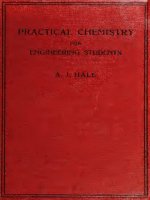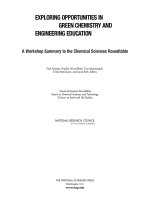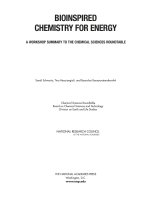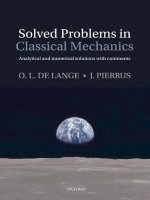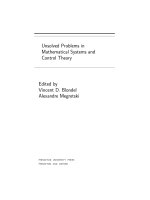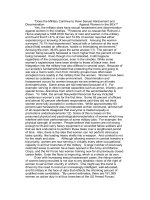Numerical Problems in Physical Chemistry for IITJEE
Bạn đang xem bản rút gọn của tài liệu. Xem và tải ngay bản đầy đủ của tài liệu tại đây (35.97 MB, 429 trang )
I
m
B
I
B
^^S^IIabli^aSenal
Problems in
AND ALL OTHER ENGINEERING ENTRANCE EXAMINATIONS
Problems in
AND ALL OTHER ENGINEERING ENTRANCE EXAMINATIONS
1. G A S E O U S S T A T E
Chapter at a glance
Basic Problems with Solution
Selected Problems with Solution
Problems for self assessment
IIT-JEE Problems with Solution
I 2. MOLE A N D E Q U I V A L E N T C O N C E P T 61-146
•
•
•
•
•
61
63
96
130
135
Chapter at a glance
Basic Problems with Solution
Selected Problems with Solution
Problems for self assessment
IIT-JEE Problems with Solution
PR?!-Til Tiriaip '
t
3. A T O M I C S T R U C T U R E
Chapter at a glance
Basic Problems with Solution
Selected Problems.with Solution
Problems for self assessment
IIT-JEE Problems with Solution
411LLI
t i l l
4. R A D I O A C T I V I T Y
Chapter at a glance
Basic Problems with Solution
Selected Problems with Solution
Problems for self assessment
IIT-JEE Problems with Solution
« i j M I
M S • "> '
203-247
203
204
215
234
237
|
H !
li'
273-338
I 6. REDOX T I T R A T I O N S
•
•
•
•
•
273
274
283
316
321
Chapter at a glance
Basic Problems with Solution
Selected Problems with Solution
Problems for self assessment
IIT-JEE Problems with Solution
7. ELECTROCHEMISTRY
•
•
•
•
•
Chapter at a glance
Basic Problems with Solution
Selected Problems with Solution
Problems for self assessment
IIT-JEE Problems with Solution
I1
KPB
liP) .
339-404
339
340
356
383
387
8. DILUTE SOLUTIONS AND COLLIGATIVE PROPERTIES 405-462
Chapter at a glance
Basic Problems with Solution
Selected Problems with Solution
Problems for self assessment
IIT-JEE Problems with Solution
j i l t
H
I
i
i
g
9. CHEMICAL KINETICS
"
r
i v , V
% Ttm-
V
K "
Chapter at a glance
Basic Problems with Solution
Selected Problems with Solution
Problems for self assessment
IIT-JEE Problems with Solution
463
466
487
507
510
•
•
•
•
•
Chapter at a glance
Basic Problems with Solution
Selected Problems with Solution
Problems for self assessment
IIT-JEE Problems with Solution
11. IONIC EQUILIBRIUM
•
•
4
•
•
Chapter at a glance
-Basic Problems with Solution
Selected Problems with Solution
Problems for self assessment
IIT-JEE Problems with Solution
wi F
It T
Ji-
pesi-
~ - -
9
12. THERMODYNAMICS
•
•
•
•
•
Chapter at a glance
Basic Problems with Solution
Selected Problems with Solution
Problems for self assessment
IIT-JEE Problems with Solution
13. THERMOCHEMISTRY
Chapter at a glance
Basic Problems with Solution
Selected Problems with Solution
Problems for self assessment
IIT-JEE Problems with Solution
14. CRYSTALLOGRAPHY
Chapter at a glance
Basic Problems with Solution
Selected Problems with Solution
Problems for self assessment
IIT-JEE Problems with Solution
705-747 I
705
707
714
735
742
•
•
•
•
Chapter at a glance
Basic Problems with Solution
Selected Problems with Solution
Problems for self assessment
• Selected Problems with Solution
• Problems for self assessment
• IIT-JEE Problems with Solution
• SOME IMPORTANT TABLES
865-872
• LOG TABLE
873-876
Gaseous State
Chapter at a Glance
1
1. lioyles law:
/'V = constant
2. ( limit's law:
V/T = constant
.1. (>ay Lussac-Charles's law:
P/T - constant
4. Avogadro's hypothesis:
V oc No. of molecules
5. (•as equalion:
PV= nRT
oi
PV=(w/m)RT
(at constant T and n)
(at constant P and n)
(at constant V and n)
(at constant pressure and temperature)
or
(>. Graham's law of diffusion:
;
n
-W MI
r2~
M\
P = ~RT
m
(where <1 is density of gas)
(at constant P and T)
(at constant T)
y
n
mi
p2
7. Dalton's law of partial pressure:
PT = FA + P'B + P'c +
and P\ = Pj x mole fraction of A
8. Absolute density:
,
mass
.
. . . . .
-i
a =—
; expressed usually in g litre
volume
9. Vapour density:
Molecular weight = Vapour density x 2
(For gases only)
10. Different speed terms for molecular motion:
"AV
=
"V j ^ / '
-x/3 RT
"rm.= V
w
^ e r e "AV ' s average speed
where « r m s is root mean square speed
2 RT
"MP = V M ; where m^p is most probable speed
"MP : "AV : "rms : : ' : 1.128 : 1.224
NUMERICAI I 'I lYSK ;AL CHEMIST HY
11. Kinetic equation:
2
PV = (l/3)m.n.ums
12. Kinetic energy:
(m is mass of one molecule and n is number of molecule)
K.E./mol = | R T
3 RT 3
Average K.E. or K.E./molecule = - — = ~kT
(k is Boltzman constant)
13. Van der Waals' Equation:
v2
p+
[V-b)=RT
(for 1 mole)
2
n a
[V-nb] = nRT
(for n mole)
V2
a is van der Waals' constant for attraction ; b is van der Waals' constant for volume.
Also b = 4-N-v
14. Boyle's temperature (7b):
a
Th =
Rb
15. Critical constants
Tc
Vc = 3 b
21b
rc> Pc and Vc are critical temperature, critical pressure and critical volume respectively.
16. Inversion temperature (7^):
2a
Ti
Rb
17. Law of corresponding state:
Pc =
27 Rb'
[3V r - I] = 8r r
P r , Vr and Tt are reduced pressure, reduced volume and reduced temperature respectively.
18. Mean free path (X):
P.d.
=
v 2< -tio N
1
2
(a is molecular diameter)
19. Collision frequency (c.f.):
c
r
'
=
"rms
20. Speciflc heat and molar heat capacities:
R
Cp -Cv :
~M
cp -Cv = R
£E :
c v "Cv = Y
c p and r v are specific heat at constant pressure and constant volume respectively,
C p and C v are molar heat capacities at constant P and V respectively.
GASEOUS STATE
6
The Basic Problems with Solutions
I'roblcm I.
> I'roblcm 2.
>• I'roblcm 3.
> I'roblcm 4.
>• I'roblcm 5.
>• I'roblcm 6.
I'roblcm 7.
•
I'roblcm 8.
> Problem 9.
> Problem 10.
> Problem 11.
> Problem 12.
> Problem 13.
> Problem 14.
> Problem 15.
«
> Problem 16.
>- I'roblcm 17.
A vessel of 120 mL capacity contains a certain amount of gas at 35°C'
and 1.2 bar pressure. The gas is transferred to another vessel of volume
180 mL at 35°C. What would be its pressure?
What will be the minimum pressure required to compress 500 dm 1 of
air at 1 bar to 200 dm 3 at 30°C?
A gas occupies 300 mL at 127°C and 730 mm pressure. What would
be its volume at STP?
Calculate the volume occupied by 7g CO at 27°C and 750 mm Hg.
Calculate the temperature of 4.0 moles of a gas occupying 5 dm at
3.32 bar. (R = 0.083 bar dm 3 K"1 mol -1 ).
Calculate the weight of CH 4 in a 9 dm 3 cylinder at 16 bar and 27"(\
(R = 0.083 bar dm 3 K - 1 )
A desiccator of internal volume one litre containing N 2 at 1 atm is
partially evacuated to final pressure of 78 mm of Hg, while T remains
constant. What is the volume of gas at this stage?
•J
In a certain region of space, there are only 5 molecules per cm of an
average. The temperature is 3 K. What is the average pressure of this
gas.
Using the equation of state PV=nRT, show that at a given temperature
density of a gas is proportional to gas pressure P.
Calculate the density of C 0 2 at 100°C and 800 mm Hg pressure.
At 0°C, the density of a gaseous oxide at 2 bar is same as that of
nitrogen at 5 bar. What is the molecular mass of the oxide?
The density of helium is 0.1784 kg/m3 at STP. If a given mass of
helium at STP is allowed to expand to 1.400 times of its initial volume
by changing P and T, compute its resultant density.
Density of a gas is found to be 5.46 g/dm 3 at 27°C at 2 bar pressure.
What will be its density at STP?
Calculate the volume occupied by 8.8 g of C 0 2 at 31.1 °C and 1 bar
pressure. R = 0.083 bar litre K _ l m o f 1 .
2.9 g of a gas at 95°C occupied the same volume as 0.184 g of hydrogen
at 17°C, at same pressure. What is the molar mass of the gas?
Assuming the same pressure in each case, calculate the mass of
hydrogen required to inflate a balloon to a certain volume Fat 100°C
if 3.5 g helium is required to inflate the balloon to half the volume V
at 25°C.
The densities of an unknown gas and 0 2 were find 0.2579 kg/m3 and
0.2749 kg/m3 at the same P and T. Calculate the mol. weight of unkown
gas.
6
NUMEHICAI I 'HYSICAL CHEMISTRY
>• Problem 18. A manometer is connected to a gas containing bulb. The open arm
reads 43.7 cm where as the arm connected to the bulb reads 15.6 cm.
If the barometric pressure is 743 mm mercury. What is the pressure of
gas in bar?
>- Problem 19. 0.75 mole solid A4 and 2 mole 0 2 are heated in a sealed bulb to react
completely and producing are compound. If product formed is also in
gaseous state, predict the ratio of final pressure at 600 K to initial
pressure at 300 K.
>- Problem 20. What will be the pressure of the gas mixture when 0.5 litre of H 2 at
0.8 bar and 2,0 litre of oxygen at 0.7 bar are introduced in a 1 litre
vessel at 27°C?
>- Problem 21. What will be the pressure exerted by a mixture of 3.2 g of methane
and 4.4 g of carbon dioxide contained in a 9 dm 3 flask at 27°C?
>• Problem 22. A closed container of volume 0.02 m 3 contains a mixture of neon and
argon gases at a temperature 27°C and pressure 1 x 105 Nrrf 2 . The
total mass of mixture is 28 g. If the gram molecular weight of neon
and argon are 20 and 40 respectively, find the masses of individual
gases in the container, assuming them to be ideal.
>- Problem 23. A jar contains a gas and a few drops of water at T K. The pressure in
the jar is 830 mm of Hg. The temperature of the jar is reduced by 1 %.
The vapour pressure of water at two temperature are 30 and 25 mm of
Hg. Calculate the new pressure in the jar.
V Problem 24. Pressure of 1 g of an ideal gas A at 27°C is found to be 2 bar when
2 g of another ideal gas B is introduced in the same flask at same
temperature the pressure becomes 3 bar. Find a relationship between
their molecular masses.
>- Problem 25. The drain cleaner, Drainex contains small bits of aluminium which
react with caustic soda to produce hydrogen. What volume of hydrogen
at 20°C and one bar will be released when 0.15 g of aluminium reacts?
>• Problem 26. 4 litre C 2 H 4 (g) burns in oxygen at 27°C and 1 atm to produce C0 2 (g)
and H 2 0(g). Calculate the volume of C 0 2 formed at (a) 27°C and
1 atm, (b) 127°C and 1 atm, (c) 27°C and 2 atm.
>- Problem 27. How many gram of C a C 0 3 be decomposed to produce 20 litre of
C 0 2 at 750 torr and 27°C.
>• Problem 28. 34.05 mL of phosphorus vapour weighs 0.0625 g at 546°C and
1 bar pressure. What is the molar mass of phosphorus?
>- Problem 29. The total pressure of a sample of methane collected over water is 735
torr at 29°C. The aqueous tension at 29°C is 30 torr. What is the
pressure exerted by dry methane?
>• Problem 30. A mixture of gases at 760 mm pressure contains 65% nitrogen, 15%
oxygen and 20% carbon dioxide by volume. What is partial pressure
of each in mm?
GASEOUS S I A I I
7
>• Problem 31. A mixture of hydrogen and oxygen al one bar pressure contains 20%
by weight of hydrogen. Calculate the partial pressure of hydrogen.
>• I'roblcm 32. Calculate the total pressure in a mixture of 8 g of oxygen and 4 g of
hydrogen confined in a vessel of 1 dm 3 at 27°C.
/? = 0.083 bar dm 3 KT1 mol - 1 .
>• Problem 33. A student forgot to add the reaction mixture to the round bottomed
open flask at 27°C and put it on the flame. After a lapse of time, he
realized his mistake, using a pyrometer he found the temperature of
the flask was 477°C. What fraction of air would have been expelled
out?
>• Problem 34. Pay load is defined as the difference between the mass of displaced
air and the mass of the balloon. Calculate the pay load when a balloon
of radius 10 m, mass 100 kg is filled with helium at 1.66 bar at 27"('.
(Density of air = 1.2 kg m~3 and R = 0.083 bar dm 3 K"1 mol" 1 ).
>• Problem 35. Calculate the total number of electrons present in 1.4 g of nitrogen
gas.
>• Problem 36. For 10 minutes each, at 27°C, from two identical holes nitrogen and
an unknown gas are leaked into a common vessel of 3 litre capacity.
The resulting pressure is 4.18 bar and the mixture contains 0.4 mole
of nitrogen. What is the molar mass of the unknown gas?
>• I'roblcm 37. Through the two ends of a glass tube of length 200 cni hydrogen
chloride gas and ammonia are allowed to enter. At what distance
ammonium chloride will first appear?
>• Problem 38. Calculate the relative rates of diffusion for 2 3 5 UF 6 and 2 3 8 UF 6 .
• Problem 39. Equal volumes of two gases A and B diffuse through a porous pot in
20 and 10 seconds respectively. If the molar mass of A be 80, find the
molar mass of B.
>- Problem 40. Calculate the total and average kinetic energy of 32 g methane molecule,
at 27°C. /? = 8.314 JK"1 mol" 1 .
>- Problem 41. Calculate the root mean square speed, total and average translational
kinetic energy in joule of the molecules in 8 g methane at 27°C.
>• Problem 42. Assuming a nitrogen molecule spherical in shape and occupying the
radius 200 pm, calculate :
(a) the volume of single molecule of gas,
(b) the percentage of empty space in one mole of N 2 gas at NTP.
>- Problem 43. Calculate the average volume available to a molecule in a sample of
N 2 at NTP. Also report the average distance between two neighbouring
molecules if a nitrogen molecule is assumed to be spherical. Comment
on the result if the radius of one N 2 molecule = 2 x 10 -8 cm 3 .
>• Problem 44. Calculate the compressibility factor for S0 2 , if 1 mole of it occupies
0.35 litre at 300 K and 50 atm pressure. Comment on the result.
8
NUMERICAL PHYSICAL CHEMISTRY
>- Problem 45. Calculate root mean square speed, most probable speed and average
speed o f :
(a) S 0 2 at STP.
(b) Ethane at 27°C and 760 mm of Hg.
(c) 0 2 if its density is 0.0081 g mL - 1 at 1 atm.
(d) 0 2 if 6.431 g of it occupies 5 litre at 750 mm.
(e) 0 3 at 92 cm and 20°C.
>• Problem 46. The average speed of an ideal gas molecule at 27°C is 0.3 m sec - 1 .
Calculate average speed at 927°C.
>- Problem 47. 6.0 g He and 12.0 g Ne molecules both having average velocity
4 x 102 ms - 1 are mixed. Calculate kinetic energy per mole of the
mixture.
GAS! OUS STAFT
Answers
1.
0.8 bar;
2.
2.5 bar;
3.
196.9 mL;
4.
6.23 litre;
5.
50 K;
6.
92.5 g;
7.
1 litre
8.
2.04 x 10"21 atm
9.
Sec Solution;
10.
1.5124 g litre"1;
70 g/mol;
12.
0.1274 g/litre;
14.
5.05 litre;
11.
13.
3
3 g/dm ;
1
15.
40 g mol" ;
16.
2.8 g;
17.
30.02;
18.
1.347 atm or 1.36 bar;
19.
l;
8.31 x 104 Pa;
20.
1.8 bar;
22.
w N e = 4 g ; m A t = 24 g
23.
817 mm
24.
1/4;
25.
202.9 mL;
26.
(a) 8 litre, (b) 10.67 litre, (c) 16 litre;
27.
80 g;
29.
705 torr;
30.
N 2 = 494 mm, 0 2 = 114 mm, C 0 2 = 152 mm;
31.
0.8 bar;
32.
56.025 bar;
33.
34.
3811 kg;
35.
3/5;
4.216 x IO23 electron;
36.
448 g mol" 1 ;
37.
81.1 cm from HC1 end;
38.
1.0043;
40.
7482.6 J; 6.21 x IO"21
21.
28.
1
124.77;
39.
20 g mol" ;
41.
6.84 x 104 cm sec - 1 , 1871.42 J, 62.14 x IO"22 J
42.
(a) 3.35 x io" 2 3 cm 3 per molecule; 43.
3.72 x i o - 2 0 cm 3 , 41.4 x 10"8 cm;
(b) 99.9%;
44.
0.711;
45.
(a) 3.26 x 104 cm sec -1 , 2.66 x 104 cm sec" 1 , 3.00 x 104 cm sec - 1 ;
(b) 4.99 x 104 cm sec" 1 , 4.07 x 104 cm sec" 1 , 4.60 x 104 cm sec" 1 ;
(c) 1.94 x io 4 cm sec" 1 , 1.58 x 104 cm sec" 1 , 1.78 x io 4 cm sec" 1 ;
(d) 4.83 x IO4 cm sec" 1 , 3.94 x 104 cm sec" 1 ,4.45 x 104 cm sec" 1 ;
(e) 3.9 x 104 cm sec" 1 , 3.18 x 104 cm sec" 1 , 3.59 x 104 cm sec" 1 ;
46.
0.6 msec" 1
47.
808.16 J/mol
NUMERICAL PHYSICAL CHEMISTRY
10
Solution
Solution 1.
Given,
Vx = 120 mL ; Px = 1.2 b a r ;
F 2 = 1 8 0 m L ; P2 = ?
Px Vx - P2V2
1.2 x 120 = />2 x 180
P2 = 0.8 bar
Solution 2.
Given, F, = 500 dm 3 ; Px = 1 bar ;
V2 = 200 dm 3 ; P2 = ? ;
1
Given: at
X
Tx = 30 + 273 = 303 K
r 2 = r,
P V
J^L
T\
Solution 3.
(at constant T)
72
T2
500 = P2 X 200 or
P2 = 2.5 b a r
r , = 4 0 0 K , T2 = 273 K (STP)
F, = 300 mL = (300/1000) litre, V2 = ?
P, = (730/760) atm, P2 = 1 atm.
^F,
/>2F2
T2
730 x 300
1 x F,
760x1000x400
273
F 2 = 0.1969 litre = 196.9 m L
Solution 4.
Given : w c o = 7g ; P = (750/760) atm ; m c o = 28;
T = 300 K
PV= (w/m) RT
750
7
— x F = — x 0.0821 x 300
760
28
F = 6.23 litre
Solution5.
Given : « = 4,
F = 5 dm 3 ,
3
P = 3.32 bar,
i? = 0.083 dm bar K mol - 1
PV= nRT
3.32 x 5 = 4 x 0.083 x T
r=50K
Solution 6.
Given:
_1
P=16bar;
F=9dm3; T=300K;
R = 0.083 bar dm 3 K _1
PV= (w/m) RT
16 x 9 = (w/16) x 0.083 x 300
w = 92.5 g
w C H 4 = 16;
GASEOUS STATE
11
Solution 7. The volume of vessel remains constant and some moles are given out.
Thus volume of gas = 1 litre.
Solution 8. Given n =
5
1
^ ; V= 1 cm 3 = 10
6.023 x l O 2 3
3
litre, 7, = 3 K
, 5x0.0821x3
p x 10~3 = 6.023 x l O 2 3
P — 2.04 x 10~21 atm
Solution 9.
PV = nRT
...(1)
w
PV= —RT
m
v
w
••• « = mJ
w
Pm
Pm
or
V =w
By eq. (2) at constant temperature for a given gas d QC P
Solution 10. Given :
v
P = (800/760) atm ;
T= 100 + 273 = 373 K;
"(2)
m C 0 2 = 44
PV = (w/m) RT
w/V = density (d)
w/V = d = (Pm/RT)
=
d
800x44
tz—rrrr;
rrr = 1.5124 gs litre
760x0.0821x373
Solution 11.
d=
X/W
N2
=
RT
5 x 28
RT
(R = 0.0821 litre atm KT1 mol 1 )
Pm
Rl
Ppxide x OToxide
RT
2 x mol. mass of oxide
~
RT
Molecular mass of gaseous oxide = 70 g/mol
W
T
Solution 12. Given — = 0.1784 kg/m J = 0.1784 g/litre at STP
_______
r
It means 1 litre of gas at STP occupies 0.1784 g weight
Now by changing P the V becomes 1.4 x l litre, where weight remains
same.
w
0.1784
,
d = ~ = — — = 0.1274 kg/m 3 = 0.1274 g/litre
Thus,
Solution 13. d(g) = 5.46 g/dm 3 ,
=
7"= 300 K,
P = 2 bar
T- 273 K,
P = 1 bar
NUMERICAL PHYSICAL CHEMISTRY
12
RT;
/?7, " P2m2
d2
(m, = m 2 for same gas)
5.46
d
Solution 14.
2x273
1x300
d=i g/dm
Given : P = 1 bar, w = 8.8 g, m = 44,
T= 304.1 K, R = 0.083 bar litre K"1 mol - 1
w
PV= ~ RT
m
8.8x0.083x304.1
5.05 litre
V=
44x1
Solution 15.
For gas
w = 2.9 g
T= 95 + 273 = 368 K,
For H 2 :
Since,
w = 0.184 g
T= 17 + 273 = 290 K,
Vyh = ^ ?h2 = P g
nr
n•g'g
R TR = Ho r,H 2
2.9
0.184
— x 368 = — — x 290
m
2
m = 40 g moli-i
Solution 16.
For H 2 :
P x
For He :
P x
v=
V
I
x
J
=
373
R X
(Vis volume of balloon)
35
x/?x298
T
WH2 = 2 . 8 g
P*V=
Solution 17.
or
P=
For g a s :
P=
For O z :
w
d
~ RT=— RT
m
m
w
Vxm
RT=
0.2579
m
0.2749
' - I T
RT
d
m
-RT
(•.• 0.2579 kg/m = 0.2579 g/litre)
RT
m = 30.02
Solution 18. The height developed due to pressure of gas = 4 3 . 7 - 15.6 = 28.1 cm
h.d.g. = 28.1 x 13.6 x 980 = 374516.8 dyne/cm 2
374516.8
f
11
GASEOUS S I A I I
gas
P
m
aim
+
, l l J
K
743
= ^
+ 0-37 = 1.347 atm
743
(P, t m = —
atm)
1.347
= 1.36 bar
0.987
Solution 19.
A
4 ( S )
+
°2(g)
0.75
2
0
0
g-atoms of A = 0.75 ><4 = 3
g-atoms of 0 = 2 x 2 = 4
Thus compound formed i s ^ 3 0 4
Initially only 0 2 was there
Finally only ^ 3 0 4 is there
LL
or
Solution 20.
For H 2 :
1
n=
PV
0.8x0.5
04
RT
RT
RT
0.7x2.0
For O z :
RT
Total moles in mixture
Using,
Now,
Solution 21.
P, x F = 2 x x 300
Pf* V= 1 x / ? x 6 0 0
1.4
~ RT
0.4
1.4
L8^
+
RT RT RT
PV= nRT for 1 litre container
^mixture * 1 = ^
* RT
= 1.8 b a r
PV= nRT
3.2
4.4
3 _ 9 litre,
P x 9 = 0.3 x 0.082 x 300
P = 0.82 atm = 0.82 x 1.013 x 105 Pa
= 8.31 x io 4 Pa
Solution 22.
Given V= 0.02 m 3 , T = 300 K, P = 1 x io 5 Nm~2, R = 8.314 J
Let a and b g be mass of Ne and Ar respectively.
Thus
a + b = 28
a
b
A Iso total mole of Ne and Ar = ~ + ~
Thus from
PV-nRT
...(i)
1
NUMERICAL PHYSICAL CHEMISTRY
14
1 X 10' x
0.02 =
a_
20
b_
+
x 8.314 x 300
40
2a + b = 32.0
By eq. (i) and (ii)
<7 = 21 g
b = 24g
Solution 23.
At T K,
gas
P,dry
...(ii)
= P,dry gas
P
4-
' moisture
830 - 30 = 800 mm
gas
Now at new temperature T\ = T- y ^ - 0.99 T
or
Since Vt = F 2 ; ~ = c o n s t t .
800 x 0.99T
•"dry gas
P gas = 1P ddry
1
gas
= 792 mm
+.1 Pmoisture
= 792 + 25 = 817 mm of Hg
Solution 24.
Given forgas A :w = 1 g,
T = 300 K, P = 2 bar
For gas B : w = 2g,
T= 300 K; P = 3 - 2 = 1 bar
(gas B + gas A) mixture shows a pressure = 3 bar
W
For A
paf=
A
mA RT;
PA
PB '
"A
wB
1
A
mB
2A1
Solution 25.
mB
m
A
1
— Xm
2
A
2
m
x
WO
For B : />BF = m RT
n
=
1
4
+ 2NaOH + 2 H 2 0
m B = 4 mA
» NaA10 2 + 3H,
0.15
Initial m o l e s
27
2
Final m o l e s
015
2 * 27
Moles of H 2 =
By PV = nRT
P=
T=
0.987 x V=
V=
0.15x3
,-3
= 8.33 X 10
2x27
1 bar = 0.987 atm ;
20 + 273 = 293 K
8.33 x 10"3 x 0.082 x 293
0.2029 litre = 202.9 ml,
GASEOUS S I A I I
15
.Solution 2<>.
C
2H4(g)
+
3
-»- 2C0 2 ( g )
°2(g)
+
2H 2 0 ( g )
(a) Under same conditions of P and 7', volume of gases react in their
inole ratio and produce the products in the same molar ratio. Thus, at
27°C and I atm.
1 vol. or I mole of C 2 H 4 gives = 2 volume C 0 2
4 vol. of C 2 H 4 gives = 2 x 4 volume C 0 2 = 8 litre C 0 2
P\V\ P2V?
(b) Now, at 127°C and 1 atm . - J r L = ~ ±
or
1x8
1xV
300
400
V= 10.67 litre
(c) Similarly at 27°C and 2 atm :
V= 16 litre
Solution 27.
CaCOi
CaO + CO,
It is thus evident that 1 mole of C 0 2 is obtained by decomposition of I
mole of CaC0 3 .
PV
Also moles of CO, =
750x20
7 6 0 x 0.0821 x 30 0
= 0.80
Thus, mole of C a C 0 3 required = 0.80
Also amount of C a C 0 3 required = 0.8 x 100 = 80 g
ilul Ion 28. Given : V= 34.05 mL, w = 0.0625 g; T= 546 + 273 = 819 K, P = 1 bar.
w
PV=
-RT
(R = 0.083 bar dm 3 K"1 mol" 1 )
m
34.05 _ 0.0625
1 X
x 0.083 x 819
1000 ~
m
m = 124.77
Solution 29.
rP
total
= P
dry methane
7 3 5 = P j j y methane
^ d r y methane
Solution 30.
Since,
=
+
water
30
torr
P' = PM X Mole fraction
760 x
760 x
'CO,
Solution 31.
+ P
65
100
15
100
114 mm
20
760 x — = 152 mm
Weight of H 2 = 20 g in 100 g mixture ;
20
Moles of H 2 = ~
494 mm
=
10
Weight of 0 2 = 80 g
16
NUMERICAL PHYSICAL CHEMISTRY
80
_5
Moles of O-,2 = — = —
32
2
Total moles = 1 0
5
^
25
P'Hi = Pj x mole fraction of H 2 = 1 *
10
25/2
= 0.8 bar
Solution 32.
. 8 1
Moles of 0 2 = ~ = ~ ;
4
Moles of H 2 = — - 2
1
9
Total moles of both gas (n) = — + 2 = —
V= 1 dm 3 , T= 300 K, R = 0.083 bar dm 3 KT1 mol - 1
PV= nRT
p =
9 x 0.083 x 300
= 56 025
bar
4x1
Solution 33.
Initial mole of air in flask =
Temperature = 21 + 273 = 300 K
Final mole of air in flask = n2
Temperature = 477 + 273 = 750 K
The volume and pressure remains constant, thus, nxTx = n2T2
n, x 300
Thus,
or
Solution 34.
2
air expelled out on heating = n, - n2 = «, - (2/5)«, = 3/5 « ,
fraction of air expelled = 3/5
Weight of balloon = 100 kg = 100 x 103 g = 105 g
4 , 4 22
,
,
Volume of balloon = - 7trJ = ~ x — x (10 x 100) cm J
= 4190 x 106 cm 3 = 4190
Weight of the gas filled in balloon
x
103 litre
1.66 x 4190 x 103 x 4
PVm
RT
0.083 x 300
6
= 1.117 x l 0 g
Total weight of (gas + balloon) = 11.17 x 105 + 105 = 12.17 x 103 g
Weight of air displaced (Volume x density) by balloon
1.2x4190xl0 6
J
6
= 5.028 x 106 g
10
Pay load =50.25 x 105 - 12.17
17 x 105 = 38.11 x 1 0 5 g
- 3 8 1 1 kg
GASEOUS STATE
1.4
N 2 = 1.4 g = — mole
Solution 35.
(WA = 6.022 x IO23)
I mole N 2 has 14 NA electron
1.4
14xl.4xJV
A electron = 0.7 NA electron
—
28 mole N 2 has
2o
= 4.216 x 10 23 electron
Solution 36.
Gas
<
Ns
V = 3 litre
I or the diffusion of both gases for 10 minutes under identical conditions
10
28
10 * nN,
M„
| "'g
"2
.(1)
(v r = n/t)
For mixture in vessel:
PV=nRT
4.18 x 3 == « x 0.083
x 300
m
e
"mix
°l
« g = rcmjx-«N = 0 . 5 0 - 0 . 4 0 = 0.10
By eq. ( 2 ) a n d ( l ) ,
0.10
28
0.4
Ma
28 x 0.4 x 0.4
M
«"
HCI
Solution 37.
,
= 4 4 8
0.10x0.10
g
m o r
P
^
NHa
Let a cm from HC1 end white fumes of NH 4 C1 are noticed.
From Graham's law
r
HCI _
r
NH,
(
M NH
;W
HC1
or
a
t
t * (200 - a)
(time of diffusion in tube for both is same)
a = 81.1 cm from HCI end.
-DL
V 36.5
•(2)
18
NUMERICAL PHYSICAL CHEMISTRY
Solution 38. According to Graham's law of diffusion
± = IK
r
2
Since
M.wt. of
235
V ML
UF 6 = 349
^"ufq _ f:352
r23«,,r-
M.wt. of
238
UF 6 = 352
= 1.0043
' ' -349
[ Mb
1
Ma
Solution 39.
V x!£_
20 v
1Imjl
80
• r-
_ 10x10x80
= 20 g mol.-1
20x20
3
. . . .
Total kinetic energy = ~nRT=
2
Solution 40.
3
32
— x — x 8.314 x 300
2
16
= 7482.6 J
3 RT
Average kmetic energy
3
8.314x300
6.023 *10 23
= 6.21 x IO"21 J
Solution 41.
T= 2 7 + 273 = 300 K
R= 8.314 x 107 erg
M r m s for
Now
3 x 8.314 x 107 x 300
3 RT^
M
CH 4 =
16
= 6.84 x 104 cm sec-1
1
2
KE/mol of CH 4 = ~ Mu
1
X
16
x
(6.84
x
104)2
= 374.28 x 10s erg mol1-1
374.28 xlO 8
• erg = •
joule
2 xlO 7
= 1871.42 Joule
KE for - mole CH 4 =
374.28 xlO 8
1
volume diffused ^
time
24
GASEOUS S I A I I
Average kinetic energy
Solution 42.
K. E./mol
• -
-
374.28 x 1 0 s
ca —
Av. No.
6.023xlO 2 3
15
= 62.14 x 10~ erg
= 62.14 x 10"22 joule
4
,
(a) Volume of 1 molecule = — nr (spherical shape)
(v
4 22
200 pm = 2 x 10"8 cm)= - x — x [2 x 10~B]
= 3.35 x IO -23 cm 3 per molecule
(b) Now volume of N molecules of N 2 = 3.35 x 10~23 x 6.02 x 10 23
= 20.177 = 20.20 cm 3 per mol
3
At NTP, volume of 1 mole = 22400 cm
Thus,
empty space = 22400 - 20.20 = 22379.8 cm 3
Thus,
Empty volume
% empty space
Available volume
22379.8
22400
= 99.9%
Solution 43.
x 100
x 100
Volume occupied by N molecules of N 2 = 22400 cm
22400
Volume occupied
by
K
J 1 molecule of N->
2 = t t t — 23
6.02 xlO
= 3.72 x IO -20 cm 3
4
Also volume of 1 molecule of N 2 = ~ nr3
~ xy
x ? = 3.72 x IO -20
r = 20.7 x 10 - 8 cm
Thus, average distance in between two N 2 molecules = 2 « r
= 41.4 x l O - * cm
8
Given radius of N 2 = 2 x 10~ cm; obtained radius is 20.7 x IO -8 . Thus,
it means that average distance between two molecules is gaseous state
is almost 10 times of the diameter of each molecule. This confirms the
empty space in gaseous state and also a reasonable justification for their
compression.
Solution 44.
Given: / ' = 50atm, r = 3 0 0 K , V= 0.35 litre, m = 64.
PV
50x0.35
= 0.711
nRT
1x0.0821x300
The Z values are lesser than 1 and thus, nRT > PV. This means to attain
Z = 1, volume must have been more at same P and Tot we can say that
S 0 2 is more compressible than ideal gas.
Z =
20
Solution 45.
NUMEHICAI PHYSICAL CHEMISTHY
(a) Given :
T= 273 K
Mrms
[3RT
13x8.314^l07
ofS02=(-u ^
-
= 3.26 x 10 4 cm sec - 1
wMP = u rms x 0.816 = 2.66 x 10 4 cm sec - 1
Now
W
AV =
u
rms
x
[3RT
3RT
M r m s 0fC 22 r 6
" ~ V M
M
(b)
0
9 2 1 3
=
3
-
0 0
V
30
= 4.99 x i o cm sec
Given T = 273 + 27 = 300 K)
Note :
If T is given, a l w a y s use
* 104 c m sec-1
3x8.314x .107 x300
4
(v
x273
-1
ums
Calculate m mp and wAV as above
« M P for C 2 H 6 = 4.07 x 10 4 cm sec - 1
wAV for C 2 H 6 = 4.60 x 10 4 cm sec - 1
(c) Given density (d) of 0 2 = 0.0081 g mL - 1 , P = 1 atm
|3Z
w
rms ~
\
Calculate mmp and m av
J
_ [Ei
1x76x13.6x981
~ \
0.0081
= 1.94 x 10 4 cm sec - 1
as above
wMP = 1.58 x 10 4 cm sec - 1
u AV = 1.78 x 10 4 cm sec - 1
(d) Given for 0 2 : w = 6.431 g, V= 5 litre, P = 750 mm.
Using
PV= (w/m) RT
750
6.431
— x 5 = — x 0 .0821 x r
r = 299.05 K
3 x 8.314 x 1Q7 x 299.05
32
= 4.83 x io 4 cm sec - 1
mmp = 3.94 x io 4 cm sec - 1
wAV = 4.45 x 10 4 cm sec - 1
(e) Given for 0 3 : T = 293 K, P = (92/76) atm
7
3RT _ 3 x 8 . 3 1 4 x l 0 x293
V M
V
48
= 3.9 x I 0 4 c m sec - 1
